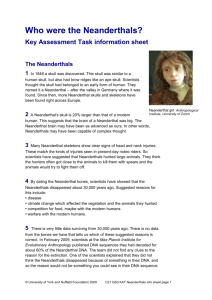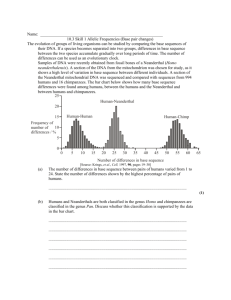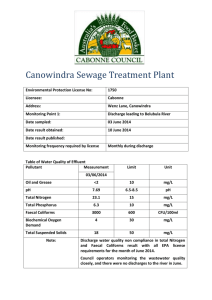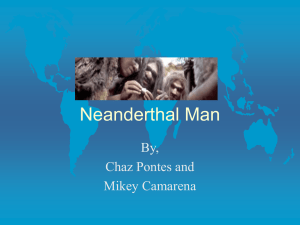The Neanderthal Meal: A New Perspective Using Faecal Biomarkers Please share
advertisement
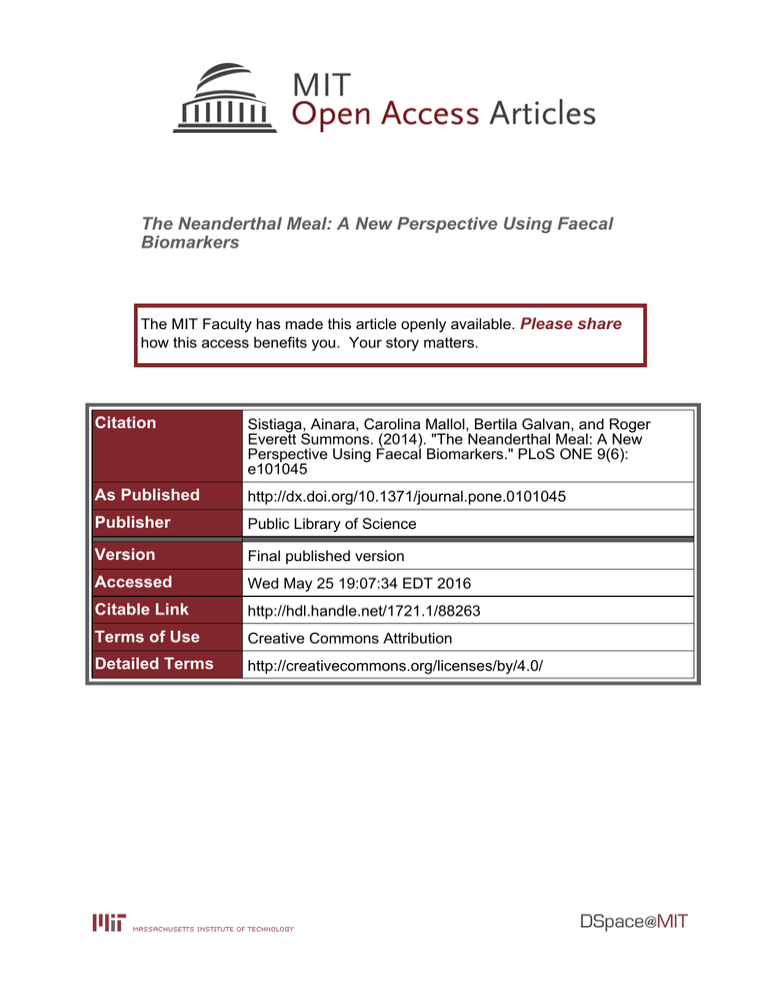
The Neanderthal Meal: A New Perspective Using Faecal Biomarkers The MIT Faculty has made this article openly available. Please share how this access benefits you. Your story matters. Citation Sistiaga, Ainara, Carolina Mallol, Bertila Galvan, and Roger Everett Summons. (2014). "The Neanderthal Meal: A New Perspective Using Faecal Biomarkers." PLoS ONE 9(6): e101045 As Published http://dx.doi.org/10.1371/journal.pone.0101045 Publisher Public Library of Science Version Final published version Accessed Wed May 25 19:07:34 EDT 2016 Citable Link http://hdl.handle.net/1721.1/88263 Terms of Use Creative Commons Attribution Detailed Terms http://creativecommons.org/licenses/by/4.0/ The Neanderthal Meal: A New Perspective Using Faecal Biomarkers Ainara Sistiaga1,2,3*, Carolina Mallol1,3, Bertila Galván1, Roger Everett Summons2 1 Department of Geography and History, University of La Laguna, Tenerife, Spain, 2 Department of Earth, Atmospheric and Planetary Sciences, Massachusetts Institute of Technology, Cambridge, Massachusetts, United States of America, 3 Instituto Universitario de Bio-Orgánica Antonio González, La Laguna, Tenerife, Spain Abstract Neanderthal dietary reconstructions have, to date, been based on indirect evidence and may underestimate the significance of plants as a food source. While zooarchaeological and stable isotope data have conveyed an image of Neanderthals as largely carnivorous, studies on dental calculus and scattered palaeobotanical evidence suggest some degree of contribution of plants to their diet. However, both views remain plausible and there is no categorical indication of an omnivorous diet. Here we present direct evidence of Neanderthal diet using faecal biomarkers, a valuable analytical tool for identifying dietary provenance. Our gas chromatography-mass spectrometry results from El Salt (Spain), a Middle Palaeolithic site dating to ca. 50,000 yr. BP, represents the oldest positive identification of human faecal matter. We show that Neanderthals, like anatomically modern humans, have a high rate of conversion of cholesterol to coprostanol related to the presence of required bacteria in their guts. Analysis of five sediment samples from different occupation floors suggests that Neanderthals predominantly consumed meat, as indicated by high coprostanol proportions, but also had significant plant intake, as shown by the presence of 5b-stigmastanol. This study highlights the applicability of the biomarker approach in Pleistocene contexts as a provider of direct palaeodietary information and supports the opportunity for further research into cholesterol metabolism throughout human evolution. Citation: Sistiaga A, Mallol C, Galván B, Summons RE (2014) The Neanderthal Meal: A New Perspective Using Faecal Biomarkers. PLOS ONE 9(6): e101045. doi:10. 1371/journal.pone.0101045 Editor: Karen Hardy, ICREA at the Universitat Autònoma de Barcelona, Spain Received January 31, 2014; Accepted June 2, 2014; Published June 25, 2014 Copyright: ß 2014 Sistiaga et al. This is an open-access article distributed under the terms of the Creative Commons Attribution License, which permits unrestricted use, distribution, and reproduction in any medium, provided the original author and source are credited. Funding: Archaeological research at El Salt is funded by the Spanish Government I+D project (HAR2012-32703 MEC-FEDER), and a Canarian Government predoctoral grant and EAOG travel award to A.S. Research at MIT was supported by a grant (NNA13AA90A) from the NASA Astrobiology Institute to R.E.S. The funders had no role in study design, data collection and analysis, decision to publish, or preparation of the manuscript. Competing Interests: The authors have declared that no competing interests exist. * Email: msistiag@ull.es microfossils and organic residues in Neanderthal teeth, all previous palaeodietary reconstructions have been based on indirect evidence where preferential or selective preservation plays a key role. We have obtained the first direct evidence of animal and plant intake by Neanderthals based on identification of human faecal biomarkers in archaeological sediments. This method has proved be an increasingly valuable tool in the identification of the likely source of faecal matter and has successfully been applied in more recent archaeological contexts [11–16]. It provides direct evidence of the digestive physiology and diet of the source organisms and provides critical data to assess the origin of faecal deposits [11,12]. We focus on sterols and stanols; lipids that are known to be relatively stable through food chains and during early diagenetic processes [17,18]. More specifically, 5b-stanols can be used as faecal biomarkers because they are uniquely formed in the intestinal tract of most higher mammals during metabolic reduction of cholesterol and phytosterols. Moreover, their relative proportions are indicative of dietary preferences [11,19]. The main actors of this microbial conversion still have to be elucidated [20], but a few cholesterol-reducing strains have been isolated [21– 24] and only one from human faeces [24]. Genes or enzymes involved in this metabolism are still unknown [25]. GC-MS analyses were carried out using a sensitive and selective detection method, that is, multiple reaction monitoring (MRM). We used precursor-product mass spectrometric transitions for Introduction Dietary differences between Neanderthals (extinct human species that lived in Eurasia between ca. 230.000 to 40.000 years ago) and anatomically modern humans have been claimed to be one of the possible causes of their disappearance [1]. The complex spectrum of food sources exploited by the latter could have represented an adaptive advantage compared to a more restricted Neanderthal diet based on high meat intake. Major progress has been made in Neanderthal dietary reconstructions by the combination of stable carbon and nitrogen isotopes [2–4]. However, since these data only reflect the principal sources of protein intake, the role of plants is underestimated and Neanderthals continue to be pictured as top-level carnivores. Supporting information comes from the high occurrence of faunal remains in Neanderthal sites showing that they were expert hunters of large herbivores with short prey variability [5]. New evidence challenging this view comes from dental calculus analysis and microfossils trapped in Neanderthal teeth [6–8]. These data present a completely different image of Neanderthals as a population that exploited and cooked a wide range of plant species. Further evidence comes from palaeobotanical remains found in archaeological deposits such as Kebara Cave or Amud Cave [9,10]. However, the preservation potential of plant remains is high in the Middle East, but low in the rest of the land inhabited by Neanderthals. In sum, except for the evidence of entrapped PLOS ONE | www.plosone.org 1 June 2014 | Volume 9 | Issue 6 | e101045 The Neanderthal Meal: A New Perspective Using Faecal Biomarkers sterol and stanols in combination with gas chromatographic retention times to establish the composition of steroidal lipids isolated from combustion structures from El Salt Unit X (Appendix S1). eluting in complex or heavily biodegraded mixtures or in very low abundances [18]. The sterols in the samples we analysed cooccurred with many other compounds in a complex mixture of overlapping peaks. The GC-MRM-MS analysis allowed us to visualise the compounds as a suite of cleanly resolved peaks from which we could reliably determine peak areas at low levels of sample consumption. GC alone would never give the same confidence for identification or quantification. We did not attempt a direct comparison with more conventional GC-MS although it is probable we could have identified their presence GC-MS in Scan or SIM mode if more material had been available to work with. Identification of compounds was achieved by comparison with reference samples and literature. We have followed a conventional organic geochemistry protocol consistent with our objective. As this study targets faecal sterols, we do not include total sterol content in our results. Work conducted independently of this study has confirmed that our GCMS analyses, when quantitation is required, are reproducible to better than 65%. Adscription of the samples to a human origin was carried out based on previously standardized ratios [11,32,36]. Therefore, no statistical treatment was necessary. Materials and Methods The archaeological setting of El Salt (Alicante, Spain), is a Middle Palaeolithic open-air site (Fig. 1A) that has yielded evidence of recurrent Neanderthal occupation dated between 60.768.9 and 45.263.4 Ka and is under current investigation [26,27]. The sediment samples belong to the stratigraphic unit under current excavation (S.U. X) and are associated with archaeological remains and sedimentary facies were excavated, sampled and documented according to a methodology geared to the identification of human occupation episodes. The selected combustion features belong to diachronous archaeological facies associations. Our evidence for animal and plant intake comes from the top of the white layer of combustion structure H44 and its overlying deposit (Fig. 1C). This ash layer has shown to be microstructurally well preserved, not reworked by bioturbation, and is overlain by a sandy clayey sediment (La8) with a sharp contact. Several millimetric phosphatic coprolites with micromorphological features resembling those reported for human coprolites [28] were identified in thin sections manufactured from oriented blocks of sediment collected from stratigraphic unit X, near the samples reported here. These coprolites are autofluorescent under blue light, have a massive groundmass and contain numerous inclusions, possibly the remains of parasitic nematode eggs or spores [29,30]. (Fig. 1D). Samples were collected by hand during surface excavation of El Salt Neanderthal site. About 10 g of sediment were scooped out using metal tools rinsed in methanol (MeOH) and dichloromethane (DCM), wrapped in aluminium foil, inserted in plastic bags and stored in a freeze room. In the laboratory, a half of the samples were pulverized to a fine powder using an agate mortar and pestle. All laboratory equipment was rinsed with high-purity acetone, MeOH and DCM in between samples to avoid cross contamination. We also analyzed fresh primate stool as control samples for biomarker identification. All glassware, aluminium foil, silica, quartz wool and quartz sand were combusted at 500uC for at least 12 hours to remove organic contamination, whereas metal tools were rinsed in MeOH and DCM. About 5 g of homogenized sediment samples were freeze dried and ultrasonically extracted 4 times with DCM/MeOH (3:1 v/v) at 40uC for 20 minutes to obtain a total lipid extract (TLE). Solvent was removed from the TLEs under a constant lowvelocity stream of N2 gas using a TurboVAP and dried samples were stored under nitrogen in glass vials with Teflon-lined caps. The TLE was then derivatised to allow identification of sterols to their trimethyl silyl ethers (TMS) using a mixture of 25 ml pyridine and 25 ml N,O-bis [trimethylsilyl]trifluoroacetamide containing 1% of trimethylchlorosilane solution (BSTFA+ 1% TCMS; SIGMA). Stenols and stanols were analyzed by GC–MRM–MS (Supplementary methods S1 in Appendix S1), using predetermined precursor–product reactions (Table S1 in Appendix S1). MRM– MS is a sensitive analytical technique performed in a doublefocusing magnetic sector mass spectrometer and measures fragmentation reactions taking place in the first field free region of the mass analyser. This approach affords high signal to noise ratio and elevated selectivity of targeted lipid classes, enabling the identification of compounds that are normally unresolved or coPLOS ONE | www.plosone.org Ethics Statement We declare that no living animals were used in this research. The soil samples used for biomarker and micromorphological analyses were collected from the archaeological site of El Salt, Alicante, Spain. The archaeological team leaded by B. Galván conducted the excavations under a government permit and following the Spanish heritage law (No. 16/1985, 25 june). All excavated material including the sedimentary material is interpreted as archaeological material so no further permits are required for the presented study. Results Our preliminary results from four of five samples show an alcohol fraction clearly dominated by coprostanol and its diagenetic product epicoprostanol, with some presence of stigmasterol, sitosterol and cholesterol (Fig. 2). A fifth sample (WL H44) also yielded higher proportions of cholesterol and coprostanol. However, significant occurrence of phytosterol metabolites, namely 5b-stigmastanol and 5b-epistigmastanol, unambiguously record the ingestion of plants (Fig. 3). Hydrocarbon analyses of the same sample did not show alkanes with odd over even predominance, diagnostic for the presence of plant leaf waxes, thereby excluding the surrounding vegetation as a direct source of these compounds. Cholesterol and phytosterols were detected in control soils sampled within a distance of .1 m from the combustion structure. However, we did not identify the presence of any 5b-stanols in these control samples. Because cholesterol to coprostanol conversion is not unique to human beings [31–35] several ratios originally used as indicators of sewage pollution have been proposed to identify the likely source of faecal matter [11,36]. Here we used the ratio proposed by Bull and coworkers [11] [coprostanol+epicoprostanol/5bstigmastanol+epi-5b-stigmastanol] in order to distinguish between omnivore, pig/human (.1), and herbivore species (,1). The value obtained using this ratio (1.78) suggests a human origin. 2 June 2014 | Volume 9 | Issue 6 | e101045 The Neanderthal Meal: A New Perspective Using Faecal Biomarkers Figure 1. Archaeological and micromorphological context. A) El Salt site during excavation; B) Field photograph showing a detail of exposed combustion structure H44 (white sediment corresponds to the top ash layer). The black sediment to the left belongs to an overlying combustion structure (H32). C) Field photograph of sediment block showing the facies described in the text in microstratigraphic succession. D) Microphotographs of a slightly burned coprolite of putative human origin identified in El Salt Stratigraphic Unit X (sample SALT-08-13). The images under plane polarized light show the pale brown color and massive structure of the coprolite, as well as the common presence of inclusions, which are possibly parasitic nematode eggs or spores. Views under blue light fluorescence (black background) shows autofluorescence indicative of high phosphate content. doi:10.1371/journal.pone.0101045.g001 show a regular presence of 5b-stanols or cholestanol, indicating that the presence of faecal biomarkers in our samples is not due to environmental contamination. Coprostanol is formed through microbial hydrogenation of its precursor D5-sterol cholesterol by the specific bacteria present in the intestinal tract of higher mammals. It is formed from both ingested and de novo biosynthesized cholesterol [11,41]. The other stanols represent direct dietary input of plant sterols, since humans Discussion and Conclusions Even though some studies [13,37–41] have reported small concentrations of coprostanol in soils generated by microbial action in reducing conditions, this represents a minor pathway in cholesterol environmental conversion, while the vast majority of cholesterol will be transformed into cholestanol. In any case, our samples from the same level and vertical sampling test did not PLOS ONE | www.plosone.org 3 June 2014 | Volume 9 | Issue 6 | e101045 The Neanderthal Meal: A New Perspective Using Faecal Biomarkers Figure 2. Sterol fraction histograms. Sterol fraction histograms from the samples reported here that yielded faecal matter. Relative concentrations are expressed as % of the largest peak compared to peak areas in the TIC. doi:10.1371/journal.pone.0101045.g002 humans during the second half of the first year of life [44] and would facilitate the elimination of excess cholesterol from the body, decreasing the risk of cardiovascular disease [45–46]. The predominance of coprostanol and a near absence of 5bstigmastanol among our samples indicate that the Neanderthals from El Salt had a meat-dominated diet. However, this must be viewed from the perspective that animal tissues contain far higher abundances of the precursor sterols than do plant tissues. Normally, the sterol content of meat is 3 times higher, gram for gram, of fresh plants such as cabbage [47,48]. Nevertheless, higher plant intake would be indicated by the presence of 5b- cannot synthesize them. The sterol composition of an animal’s diet, and the amount of plant material in particular, has a clear impact on stanol profile. Analyses reported for other animals such as dogs and birds contain only trace amounts of 5b-stanols probably due to the lack of sterol-reducing bacteria [31–35]. In humans, the conversion of cholesterol to coprostanol is bimodal with a vast majority of high converters and a minority of low to inefficient converters (coprostanol content representing less than one-third of faecal sterol content) [42,43]. The efficiency of cholesterol conversion depends mainly from the abundance of cholesterol-reducing bacteria [25]. This microbial action starts in PLOS ONE | www.plosone.org 4 June 2014 | Volume 9 | Issue 6 | e101045 The Neanderthal Meal: A New Perspective Using Faecal Biomarkers Figure 3. Partial chromatogram showing evidence for plant intake. Partial chromatogram of summed GC-MS transition for C27+C28+C29 sterols and stanols from the oldest sample (WL H44). Retention peaks matched those of reference samples of fresh faecal matter from primates and herbivores. doi:10.1371/journal.pone.0101045.g003 stigmastanol. For example, consumption of tubers would yield a significant proportion of this plant’s digestion products. This disagrees with claims of preservation bias hampering our ability to identify consumption of tubers (underground storage organs) and other plants [6]. In fact, the tandem occurrence of 5b-stigmastanol from the oldest sample (WL H44) points to some plant intake (Fig. 3). According to Buck and Stringer [49], this could either represent direct consumption of plants or stomach contents of animals that had consumed plants. Taken together, these data suggest that the Neanderthals from El Salt consumed both meat and vegetables, in agreement with recent hypotheses based on indirect evidence. Future studies in Middle Palaeolithic sites using the faecal biomarker approach will help clarify the nature, role and proportion of the plant component in the Neanderthal diet, and allow us to assess whether our results reflect occasional consumption or can be representative of their staple diet. Also, this data represents the oldest positive identification of human faecal matter, in a molecular level, using organic geochemical methods. Besides having corroborated our method and obtained the first evidence of an omnivorous Neanderthal diet from faeces, our results also have implications regarding digestive systems and gut microbiota evolution. Approaching the evolution of the human digestive system is difficult because there is no fossil record indicating soft tissue preservation. Our results show that Nean- derthals, like anatomically modern humans, have a high rate of conversion of cholesterol to coprostanol due to the presence of bacteria capable of doing so in their guts. Further research will allow us explore this issue in the context of human evolution. Supporting Information Appendix S1 Supplementary methods S1, Gas Chromatography – Multiple Reaction Monitoring – Mass Spectrometry (GC–MRM–MS). Table S1, MRM-GC-MS Precursor-Product Transitions. (DOCX) Acknowledgments We are grateful to C. Colonero, Lab Manager of the Summons Lab, for technical assistance. We also thank Christine Pümpin from the Institute for Prehistory and Archaeological Science at the University of Basel, for useful comments and use of the institute’s fluorescence microscopy module. Author Contributions Conceived and designed the experiments: AS CM RES. Performed the experiments: AS RES. Analyzed the data: AS CM RES. Contributed reagents/materials/analysis tools: RES. Wrote the paper: AS CM RES. Provide samples: AS BG. References 6. Hardy BL (2010) Climatic variability an plant food distribution in Plestoicene europe: Implications for Neanderthal diet and subsistence. Quat Sci Rev. 29: 662–679. 7. Hardy K, Buckley S, Collins MJ, Estalrrich A, Brothwell D, et al. (2012) Neanderthal medics? Evidence for food, cooking and medicinal plants entrapped in dental calculus. Naturwissenchaften 99: 617–626. 8. Henry AG, Brooks AS, Piperno DR (2011) Microfossils in calculus demonstrate consumption of plants and cooked food in Neanderthal diets (Shanidar III, Iraq; Spy I and II, Belgium), Proc Natl Acad Sci. 108: 486–491. 9. Madella M, Jones MK, Goldberg P, Goren Y, Hovers E. (2002) The Explotaition of Plant Resources by Neanderthals in Amud cave (Israel): The Evidence from Phytolith Studies. J Archaeol Sci. 29: 703–719. 10. Lev E, Kislev ME, Bar-Yosef O (2005) Mousterian Vegetal Food in Kebara Cave, Mt. Carmel. J Archaeol Sci. 32 (3): 475–484. 11. Bull I, Lockheart MJ, Elhmmali MM, Roberts DJ, Evershed RP (2002) The Origin of Faeces by Means of Biomarker Detection. Environ Int. 27: 647–654. 1. Trinkaus T (2007) European Early Modern Humans and the Fate of Neanderthals. Proc Natl Acad Sci USA. 104: 7367–7372 2. Bocherens H (2009) ‘‘Neanderthal Dietary Habits: Review of the Isotopic Evidence’’ in The Evolution of Hominin Diets: Integrating Approaches to the Study of Palaeolithic Subsistence, eds. J.-J. . Hublin and m.P. . Richards (NY: Springer) 241–250. 3. Richards MP, Trinkaus E (2009) Isotopic Evidence for the Diets of European Neanderthal and Early Modern Humans. Proc Natl Acad Sci USA. 106: 16034– 16039. 4. Ecker M, Bocherens H, Julien MA, Rivals F, Raynal JP, et al. (2013) Middle Pleistocene Ecology and Neanderthal Subsistence: Insights from Stable Isotope Analyses in Payre (Ardèche, southeastern France). J of Human Evol. 65(4): 363– 373. 5. Gaudzinski-Windheuser S, Kindler L (2012) The Evolution of Hominin Food Resource Explotaition in Pleistocene Europe: Recent Studies in Zooarchaeology. Quat Int. 252: 1–2. PLOS ONE | www.plosone.org 5 June 2014 | Volume 9 | Issue 6 | e101045 The Neanderthal Meal: A New Perspective Using Faecal Biomarkers 12. D’Anjou RM, Bradley RS, Balascio NL, Finkelstein DV (2012) Climate impacts on human settlelments and agricultural activities in Northern Norway revelead through sediment biochemistry. Proc Natl Acad Sci. 109: 20332–20337. 13. Evershed RP, Bethel PH, Reynolds PJ. Walsh NJ (1997) 5b-Stigmastanol and Related 5b-Stanols as Biomarker of Manuring: Analysis of Modern Experimental Material and Assessment of the Archaeological Potential. J Archaeol Sci. 24: 485–495. 14. Gülaçar FO, Susini A, Klohn M (1990) Preservation and Post-mortem Transformations of Lipids in Samples from a 4000-Year-old Nubian Mummy. J Archaeol Sci. 17: 691–705. 15. Lin DS, Connor WE, Napton LK, Heizer RF (1978) The steroids of 2000-yearold human coprolites. J Lipid Res. 19: 215–221. 16. Sistiaga A, Berna F, Laursen R, Goldberg P (2014) Steroidal Biomarker Analysis of a 14,000 Years Old Putative Human Coprolite from Paisley Cave, Oregon. J Archaeol Sci. 41, 813–817. Available: http://dx.doi.org/10.1016/j.jas.2013. 10.016. 17. Floate MJS (1970) Decomposition of organic materials from hill soils and pastures: II. Comparative studies on the mineralization of carbon, nitrogen and phosphorus from plant materials and sheep faeces. Soil Bio Biochem. 2 (3): 173– 185. 18. Peters KE, Walters CC, Moldowan JM (2005) The Biomarker Guide. Volume 1: Biomarkers and Isotopes in the Environment and Human History. Cambridge University Press. 19. Macdonald IA, Bokkenheuser JW, McLernon AM, Mosbach EH (1983) Degradation of steroids in the human gut. J Lipid Res. 24: 675–694. 20. Veiga P, Juste C, Lepercq P, Saunier K, Beguet F, et al. (2005) Correlation between faecal microbial community structure and cholesterol-to-coprostanol conversion in the human gut. FEMS Microbiol Lett. 242: 81–86. 21. Eyssen HJ, Parmentier GG, Compernolle FC, de Pauw G, Piessens-Denef M (1973) Biohydrogenation of sterols by Eubacterium ATCC 21,408-Nova species. Eur J Biochem 1973, 36: 411–421. 22. Freier TA, Beitz DC, Li L, Hartman PA (1994) Characterization of Eubacterium coprostanoligenes sp. nov., a cholesterol-reducing anaerobe. Int J Syst Bacteriol. 44: 137–142. 23. Ren D, Li L, Schwabacher AW, Young JW, Beitz DC (1996) Mechanism of colesterol reduction to coprostanol by Eubacterium coprostanoligenes ATCC 51222. Steroids 61: 33–40. 24. Gérard P, Lepercq P, Leclerc M, Gavini F, Raibaud P, et al. (2007) Bacteroides sp. strain D8, the first cholesterol-reducing bacterium isolated from human feces. Appl Environ Microbiol. 73: 5742–5749. 25. Gérard P (2014) Metabolism of Cholesterol and Bile Acids by the Gut Microbiota. Pathogens, 3(1): 14–24. 26. Mallol C, Hernández CM, Cabanes D, Sistiaga A, Machado J, et al. (2013) The Black Layer of Middle Palaeolithic Combustion Structures. Interpretation and Archaeostratigraphic Implications. J Archaeol Sci. 40: 2515–2537. 27. Garralda MD, Galván B, Hernández CM, Mallol C, Gómez JA, et al. (2014) Neanderthals from El Salt (Alcoy, Spain) in the Context of the Latest Middle Palaeolithic Populations from the Southeast of the Iberian Peninsula. J Human Evol. In press. 28. Goldberg P, Berna F, Macphail R (2009) Comment on ‘‘DNA from Pre-Clovis Human Coprolites in Oregon, North America’’, Science, 325: 148-c. 29. Pümpin C, Pichler S (2010) Micromorphology and parasite eggs. A neglected source of data on former living and environmental conditions? Poster presented at the 550 Jahre Wissen Bewegt UNS Meeting, Basel, Switzerland. 30. Bouchet F, Harter S, Le Bailly M (2003) The state of the art of paleoparasitological research in the Old World. Memorias do Instituto Oswaldo Cruz 98: 95–101. PLOS ONE | www.plosone.org 31. Leeming R, Ball A, Ashbolt N, Nichols P (1996) Using faecal sterols from humans and animals to distinguish faecal pollution in receiving waters. Water Res. 30(12): 2893–2900. 32. Shah VG, Hugh Dunstan R, Geary PM, Coombes P, Roberts TK, et al. (2007) Evaluating potential applications of faecal sterols in distinguishing sources of faecal contamination from mixed faecal samples. Water Res. 41(16): 3691–3700. 33. Nichols PD, Leeming R, Rayner MS, Latham V (1996) Use of capillary gas chromatography for measuring fecal-derived sterols application to stormwater, the sea-surface microlayer, beach greases, regional studies, and distinguishing algal blooms and human and non-human sources of sewage pollution. J of Chromat A 733(1): 497–509. 34. Elhmmali MM, Roberts DJ, Evershed RP (2000) Combined analysis of bile acids and sterols/stanols from riverine particulates to assess sewage discharges and other fecal sources. Environ sci & technol 34(1): 39–46. 35. Tyagi P, Edwards DR, Coyne MS (2008) Use of sterol and bile acid biomarkers to identify domesticated animal sources of fecal pollution. Water, Air, and Soil Pollution 187(1–4): 263–274. 36. Furtula V, Osachoff H, Derksen G, Huajir H, Colodey A, et al. (2012) Inorganic nitrogene, sterol and bacterial source tracking as Tools to characterize water quality and possible contamination sources in surface water. Water Res. 46: 1079–1092. 37. Gaskell SJ, Eglinton G (1975) Rapid hydrogenation of sterols in a contemporary lacustrine sediment. Nature 254: 209–211. 38. Grimalt JO, Fernandez P, Bayona JM, Albaiges J (1990) Assessment of fecal sterols and ketones as indicators of urban sewage inputs to coastal waters. Environ Scie & Technol 24(3): 357–363. 39. Bethell PH, Goad LJ, Evershed RP, Ottaway J (1994) The study of molecular markers of human activity: the use of coprostanol in the soil as an indicator of human faecal material. J Archaeol Sci 21(5): 619–632. 40. Bull ID, Betancourt PP, Evershed RP (2001) An Organic Geochemical Investigation of the Practice of Manuring at a Minoan site on Pseira Island, Crete. Geoarchaeology 16(2): 223–242. 41. Murtaugh JJ, Bunch RL (1967) Sterols as a measure of fecal pollution. Journal (Water Pollution Control Federation) 404–409. 42. Midtvedt T, Lingaas E, Carlstedt-Duke B, Høverstad T, Midtvedt AC, et al. (1990) Intestinal microbial conversion of cholesterol to coprostanol in man. APMIS 98: 839–844 43. Wilkins TD, Hackman AS (1974) Two patterns of neutral sterol conversion in the feces of normal North Americans. Cancer Res. 34: 2250–2254 44. Midtvedt AC, Midtvedt T (1993) Conversion of cholesterol to coprostanol by the intestinal microflora during the first two years of human life. J Pediatr Gastroenterol Nutr. 17: 161–168. 45. Illman RJ, Storer GB, Topping DL (1993) White wheat flour lowers plasma cholesterol and increases cecal steroids relative to whole wheat flour, wheat bran and wheat pollard in rats. J Nutr. 123(6): 1094. 46. Navder KP, Fryer EB, Fryer HC (1992) Neutral sterol excretions in rats fed skim milk and skim milk yogurt diets. Indian journal of medical sciences, 46(9), 275. 47. Chizzolini R, Zanardi E, Dorigoni V, Ghidini S (1999) Calorific value and cholesterol content of normal and low-fat meat and meat products. Trends Food Sci Tech 10(4): 119–128. 48. Normen L, Johnsson M, Andersson H, Van Gameren Y, Dutta P (1999) Plant sterols in vegetables and fruits commonly consumed in Sweden. Eur J Nutr 38(2): 84–89. 49. Buck LT, Stringer CB (2013) Having the stomach for it: a contribution to Neanderthal diet? Quat Sci Rev. http://dx.doi.org/10.1016/j.quascirev.2013. 09.003 6 June 2014 | Volume 9 | Issue 6 | e101045
